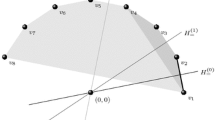Abstract
A family of polytopes, correlation polytopes, which arise naturally in the theory of probability and propositional logic, is defined. These polytopes are tightly connected to combinatorial problems in the foundations of quantum mechanics, and to the Ising spin model. Correlation polytopes exhibit a great deal of symmetry. Exponential size symmetry groups, which leave the polytope invariant and act transitively on its vertices, are defined. Using the symmetries, a large family of facets is determined. A conjecture concerning the full facet structure of correlation polytopes is formulated (the conjecture, however, implies that NP=co-NP).
Various complexity results are proved. It is shown that deciding membership in a correlation polytope is an NP-complete problem, and deciding facets is probably not even in NP. The relations between the polytope symmetries and its complexity are indicated.
Similar content being viewed by others
References
J.S. Bell, “On the Einstein-Podolsky-Rosen Paradox”,Physics 1 (1964) 195–200.
E.P. Wigner, “On hidden variables and quantum mechanical probabilities,”American Journal of Physics 38 (1970) 1005–1009.
J.F. Clauser, M.A. Horne, A. Shimony and R.A. Holt, “Proposed experiment to test local hidden variable theories,”Physical Review Letters 23 (1969) 880–884.
J.F. Clauser and M.A. Horne, “Experimental consequences of objective local theories,”Physical Review D 10 (1974) 526–535.
A. Fine, “Hidden variables, joint probability and Bell inequalities,”Physical Review Letters 48 (1982) 291–295.
A. Garg and N.D. Mermin, “Farkas lemma and the nature of reality, statistical implications of quantum correlations,”Foundations of Physics 14 (1984) 1–39.
I. Pitowsky, “The range of quantum probability,”Journal of Mathematical Physics 27 (1986) 1556–1565.
I. Pitowsky,Quantum Probability, Quantum Logic, Lecture Notes in Physics No. 321 (Springer, Berlin, 1989).
S. Kirkpatrick and D. Sherrington,” Infinite-ranged models of spin glasses,”Physical Review B 17 (1978) 4384–4403.
J.J. Hopfield, “Neural networks and physical systems with emergent collective computational abilities,” in:Proceedings at the National Academy of Sciences USA 79 (1982) 2554–2558.
F. Barahona, “On the computational complexity of ising spin glass models,”Journal of Physics A 15 (1982) 3241–3253.
G. Boole,The Laws of Thought (Dover, New York (original edition 1854)).
T. Hailperin, “Best possible inequalities for the probability of a logical function of events,”American Mathematical Monthly 72 (1962) 343–359.
T. Hailperin,Boole's Logic and Probability (North-Holland, Amsterdam, 1986, 2nd ed.).
C.E. Bonferroni, “Il calcolo delle assicurazioni su grouppi di teste,”Studi in Onore del Professor S.O. Carboni (Roma, 1936).
K.L. Chung, “On the probability of the occurrence of at leastm events amongn arbitrary events,”Annals of Mathematical Statistics 12 (1941) 328–338.
M. Fréchet,Les Probabilités Associées a un Système D'événements Compatible et Dépendants (Hermann, Paris,Vol I 1940,Vol II 1943).
S. Kounias and J. Marin, “Best linear Bonferroni bounds,”SIAM Journal of Applied Mathematics 30 (1976) 307–323.
D. Hunter, “An upper bound for the probability of a union,”Journal of Applied Probability 13 (1976) 597–603.
M. Cerasoli, “On the probability of a Boolean polynomial of events,”Discrete Mathematics 44 (1983) 221–227.
W. Maurer, “Bivalent trees and forests or upper bounds for the probability of a union revisited,”Discrete Applied Mathematics 6 (1983) 157–171.
R.M. Karp and C.H. Papadimitriou, “On linear characterization of combinatorial optimization problem,” in:Proceedings of the 21 Symposium on the Foundations of Computer Science (1980) pp. 1–9.
L.G. Khacian, “A polynomial algorithm for linear programming,”Dolkady Academie Nauk SSSR 244(5) (1979) 1093–1096.
C.H. Papadimitriou and D. Steiglitz,Combinatorial Optimization, Algorithms and Complexity (Prentice-Hall, Englewood Cliffs, NJ, 1982).
T.J. Schafer, “The complexity of satisfiability problems,” in:Proceedings of the 10th Annual Symposium on Theory of Computing (ACM, New York, 1978) pp. 216–226.
M.R. Garey and D.S. Johnson,Computers and Intractability, A Guide to the Theory of NP completeness (Freeman, New York, 1979).
C.H. Papadimitriou and M. Yannakakis, “The complexity of facets (and some facets of complexity),”Journal of Computing System Science 28 (1984) 244–259.
Author information
Authors and Affiliations
Rights and permissions
About this article
Cite this article
Pitowsky, I. Correlation polytopes: Their geometry and complexity. Mathematical Programming 50, 395–414 (1991). https://doi.org/10.1007/BF01594946
Received:
Revised:
Issue Date:
DOI: https://doi.org/10.1007/BF01594946




